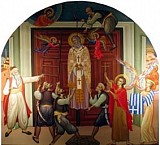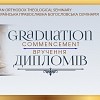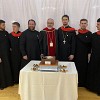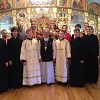SAINT SOPHIA UKRAINIAN ORTHODOX THEOLOGICAL SEMINARY
PRESS RELEASE
Graduating Class Visits Ecumenical Patriarchate – DAY 1-3
Four graduating seminarians of St. Sophia Ukrainian Orthodox Theological Seminary of South Bound Brook, NJ Rev. Frs. Andriy Matlak, Vasyl Dovgan, Vasyl Pasakas and Deacon Philip Harendza left with His Grace Bishop Daniel, Dean of Students of St. Sophia Seminary for a visit to Constantinople (Istanbul, Turkey), at the invitation of the Ecumenical Patriarchate. This trip became a reality due to a full scholarship received from the Archons of Ecumenical Patriarchate that enables graduating students to spend about 10 days in Constantinople, learning about the ministry of the Ecumenical Patriarchate and the history of the relationship between the Patriarchate (Mother Church) and Kyiv Rus, the cradle of Ukrainian Orthodoxy, whose 1025th anniversary of Baptism is marked in 2013.
The group of pilgrims left the Metropila Center of the Ukrainian Orthodox Church of the USA with the blessing of His Eminence Metropolitan Antony, the First Hierarch of the Church on Monday, April 8, 2013. Following the arrival to Istanbul, Turkey on April 9, 2013 the pilgrims of the Seminary spent their first full day (April 10, 2013) participating in Matins, Hours and Liturgy of Presanctified Gifts at the Patriarchal Cathedral of St. George. His Grace Bishop Daniel and the clergy of the Ukrainian Orthodox Church of the USA participated in the liturgical services, receiving Most Holy Eucharist at the cathedral’s sacred altar. After a short break, the group was received by the staff of the Patriarchal English Language Office, especially by Rev. Deacon Nephon Tsimalis , who graciously provided a tour of the cathedral and in the presence of Archimandrite Vissarion, the student body of St. Sophia Seminary was blessed to venerate the relics of St. John Chrysostom, Patriarch of Constantinople, St. Gregory the Theologian, St. Basil the Great, St. Solomia, St. Euphimia among other numerous relics and sacred icons of the Great Cathedral of the Ecumenical Patriarchate.
Noteworthy moment on Wednesday, April 10 was a prayerful observance of the anniversary of martyrdom of Patriarch Gregory V (who was Ecumenical Patriarch of Constantinople from 1797 to 1798, from 1806 to 1808 and from 1818 to 1821. He was responsible for much restoration work to the Patriarchal Cathedral of St George, which had been badly damaged by fire in 1738. At the onset of the Greek War of Independence, as Ethnarch of the Orthodox Millet Gregory V was blamed by Ottoman Sultan Mahmud II for his inability to suppress the Greek uprising, even though he had actually condemned the Greek revolutionary activities. He was taken out of the Patriarchal Cathedral on Easter Sunday, 1821, directly after celebrating the solemn Easter Liturgy, and hanged (in full Patriarchal vestments) for three days from the main gate of the Patriarchate compound by order of the Sultan; his body was then taken down and delivered to a squad of minorities who dragged it through the streets and finally threw it into the Bosphorus. The body was later recovered by Greek sailors and was eventually enshrined in the Metropolitan Cathedral of Athens…In his memory, the Saint Peter Gate, once the main gate of the Patriarchate compound, was welded shut in 1821 and has remained shut ever since.) Namely there, by the gate to the Patriarchate - His Grace Bishop Daniel concelebrating with Fr. Vasyl Dovgan, Fr. Andriy Matlak, Fr. Vasyl Pasakas and Deacon Philip Harendza served a memorial service, reflecting upon the ministry of the late Patriarch and his sacred suffering.
Later the same day, the seminarians and Bishop Daniel paid a prayerful and spiritually uplifting visit to Hagia Sophia Cathedral in Constantinople (The first great church on the site was built by Constantius II, the son of Constantine the Great and dedicated in 360. It was burned down during the Nika riots of 532. The building was rebuilt in its present form between 532 and 537 under the personal supervision of emperor Justinian the Great. It is one of the greatest surviving examples of Byzantine architecture. Of great artistic value was its decorated interior with mosaics and marble pillars and coverings. The temple itself was so richly and artistically decorated that Justinian is believed to have said: "Solomon, I have surpassed you!.." For over 900 years the Hagia Sophia was the seat of the Patriarch of Constantinople and a principal setting for imperial ceremonies. It was converted to a mosque at the Fall of Constantinople to the Ottoman Turks under Sultan Mehmet II in 1453. Since Islam considers the depiction of the human form to be blasphemous— that is, it is iconoclastic - Hagia Sophia's iconographic mosaics were covered with plaster. For almost 500 years the principal mosque of Istanbul, Ayasofya, served as model for many of the Ottoman mosques of Constantinople such as the Shehzade Mosque, the Suleiman Mosque, and the Rustem Pasha Mosque. In 1934, under Turkish president Kemal Atatürk, Hagia Sofia was secularized and turned into the Ayasofya Museum. Nevertheless, the mosaics remained largely plastered over, and the building was allowed to decay. Following 1993 UNESCO mission to Turkey major cleaning, roofing and restoration have been undertaken…) With the blessing of the Ecumenical P atriarch, one of the staff members of the Patriarchate escorted the group of Ukrainian Orthodox pilgrims to the Cathedral, offering a detailed tour and a valuable lesson about the historical significance of the cathedral and the impact of historical events on the life of the Ecumenical Patriarchate and the entire Orthodox world.
The first full day of activities concluded with a short visit to the Basilica of Cisterns (Justinian Cisterns). The Basilica Cistern is the largest of several hundred ancient cisterns that lie beneath the city of Istanbul (formerly Constantinople), Turkey. The cistern, located 500 feet (150 m) southwest of the Hagia Sophia on the historical peninsula of Sarayburnu, was built in the 6th century during the reign of Byzantine Emperor Justinian I. The name of this subterranean structure derives from a large public square on the First Hill of Constantinople, the Stoa Basilica, beneath which it was originally constructed. Before being converted to a cistern, a great Basilica stood in its place, built between the 3rd and 4th centuries during the Early Roman Age as a commercial, legal and artistic centre. The basilica was reconstructed by Ilius after a fire in 476… Ancient texts indicated that the basilica contained gardens, surrounded by a colonnade and facing the Hagia Sophia. According to ancient historians, Emperor Constantine built a structure that was later rebuilt and enlarged by Emperor Justinian after the Nika riots of 532, which devastated the city… The enlarged cistern provided a water filtration system for the Great Palace of Constantinople and other buildings on the First Hill, and continued to provide water to the Topkapi Palace after the Ottoman conquest in 1453 and into modern times.
On Thursday, April 11, 2013 the graduating class of St. Sophia Seminary, accompanied by His Grace Bishop Daniel and Rev. Fr. Victor and Dobrodijka Ivanna Wronsky, were received by His All Holiness Ecumenical Patriarch Bartholomew, who with the fatherly love embraces the seminarians-priests, inquiring about their studies and sharing with them a valuable reflection on the history of the spiritual relationship between the Great Church of Christ and Kyivan Rus, which led to the Baptism of the entire nation in 988, thus establishing Holy Orthodoxy on modern Ukrainian lands. His All Holiness presented each of the students with personal gifts, while His Grace Bishop Daniel shared with the Patriarch the history of the establishment of St. Sophia Seminary and informed the Patriarch of the academic and spiritual formation of seminarians of the UOC of the USA. Following a 30 minute conversation with the students and Bishop Daniel, the seminarians presented His All Holiness Ecumenical Patriarch with a hand written cross, written by the monastics of the monastery of Kyiv Caves and commissioned precisely for this first historic visit of the seminarians of the Ukrainian Orthodox Church of the USA to the Ecumenical Patriarchate. Fr. Vasyl Pasakas spoke on behalf of the graduation class, reflecting upon the spiritual connection of St. Sophia Cathedral of Constantinople and St. Sophia Cathedral in Kyiv and the significance of this first meeting of the seminarians with the Ecumenical Patriarch. At the end, the Patriarch presented His Grace Bishop Daniel with a panagia, with the depiction of Christ the Teacher.
As the lunch time approached, His All Holiness invited Bishop Daniel and seminarians to the Patriarchal Dining Hall. Prior to the beginning of the luncheon, the seminarians chanted prayer “Our Father” in Ukrainian language, beseeching Patriarchal blessing upon the food presented at the table. In conclusion of the visit, the Patriarch informed Bishop Daniel and seminarians that he is asking them to join him for a service of the Salutations to the Birth-Giver of God at the Dormition of the Theotokos Church in Yenikoy on Friday, April 12, 2013.
The day concluded with educational visits to the Monastery of Panagia Vlahernon, Museum of Pammakaristos as well as the Holy Taxiarchae parish, which hosted a dinner in honor of His Grace Bishop Daniel and seminarians-priests of the Ukrainian Orthodox Church of the USA.
Please, come back for additional information about the pilgrimage of graduating class of St. Sophia Ukrainian Orthodox Theological Seminary to Constantinople.
|
| |||||||||||||








